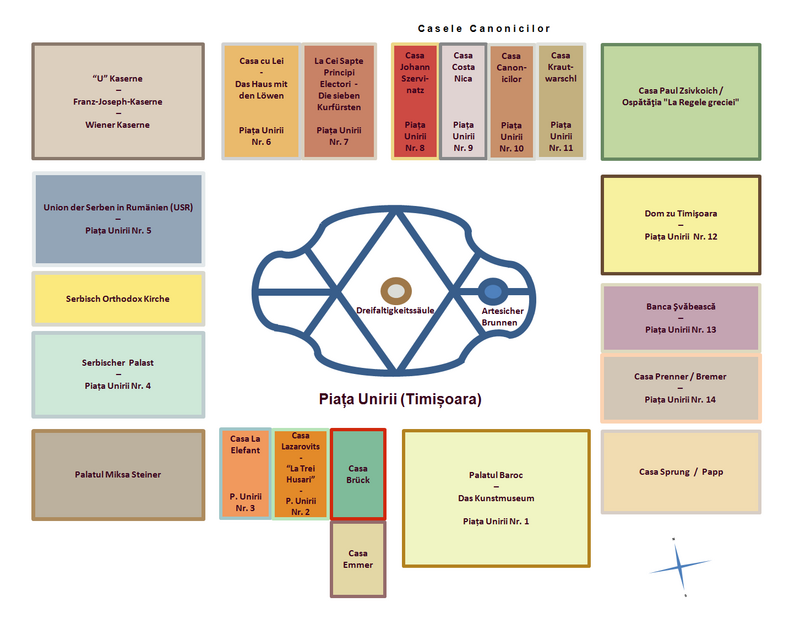Piața Unirii (Timișoara)
Piața Unirii ( German place of association ), colloquially Domplatz (Romanian Piața Domului , Hungarian Dóm-tér ), is the oldest square in the city of Timișoara in Romania . It lies in the old fortress core of Cetate and is lined with baroque , mostly pastel-colored churches and palaces , most of which were built in the 18th and 19th centuries.
Name of the place
The name of the square goes back to the decision of the people's assembly of the Banat Swabians in 1919, in which 40,000 participants voted for the unification of their areas with Romania . Romanian troops had arrived on the square in advance. During the time of the Kingdom of Hungary , the square was called Losonczy-tér . It was named after István Losonczy, who defended the city against the troops of the Ottoman Empire in 1552 as the fortress commander . Before the Austro-Hungarian Compromise of 1867 , it was called Hauptplatz .
description
The square is dominated by the Timișoara Cathedral , the cathedral of the Timișoara diocese built between 1732 and 1763 . Before that, a market was held on the square. During the 18th century it was the commercial center of the city and a venue for military parades and religious ceremonies. In addition to the cathedral, numerous historical monuments line the square, including the baroque palace (also county house or Prefectura Veche ), the house with the lions , the Serbian Orthodox cathedral and the Serbian bishopric .
In the center of the square there is the Trinity statue and an artesian well over 400 meters deep , from which sulphurous thermal water gushes. The neighboring houses Brück and Emmer are also worth seeing . The architect László Székely made the plans for the Art Nouveau buildings erected between 1908 and 1910 .
Francis Joseph Barracks built two more houses on the northwest side of the square. The former discount bank with Hungarian ornaments was built between 1906 and 1908 by the architects Marcell Komor and Dezső Jakab in the south-west of the square.
Today restaurants and cafés line the Piața Unirii, in summer there are also pubs , and there are also stages at city festivals or concerts. The Nikolaus-Lenau-Lyceum (Gheorghe-Lazăr-Strasse), the synagogue in the city center (Mărăseşti-Strasse) and the Dicasterial Palace (Prinz-Eugen-Strasse) are in the immediate vicinity of the Cathedral Square .
Trivia
On the south side of the square was the first hotel in Timisoara, To the Seven Electors . This economy was among other things the subject of the novel The Great Swabian Train by Adam Müller-Guttenbrunn .
On October 3, 2009, on the sidelines of the UEFA Europa League football match, FC Timișoara : Dinamo Zagreb (3-0), rioting took place on the pitch with 160 arrests.
Web links
- Panoramic view of Piața Unirii. onYouTube, accessed December 15, 2019.
- Timișoara, the little Vienna. In: rumaenien-info.at
- Klemens Jäger: City portrait of Timișoara. In: aurora-magazin.at
- Timișoara City Highlights. In: romaniatourism.com (English)
- Timişoara - Plăcuţe de semnalizare pe clădirile monument-istoric. In: banaterra.eu (Romanian)
Individual evidence
- ↑ Timisoara - old street names. In: kulturraum-banat.de
- ↑ Eva Kondor: JAKAB, Dezso (1864-1932) and KOMOR, MARCELL (1868 to 1944). In: jewishvirtuallibrary.org
- ↑ Adam Müller-Guttenbrunn : The great Swabian train . Staackmann Verlag, 9th edition, 1953.
- ↑ Georg Grega: History Mehalas. In: mehala.de
- ^ Unrest on the Piața Unirii after the soccer game on October 3, 2009. on YouTube , accessed on December 15, 2019.
- ↑ 160 arrests near Timisoara - Dinamo Zagreb. In: Liechtensteiner Volksblatt of October 2, 2009.
Coordinates: 45 ° 45 ′ 28.6 " N , 21 ° 13 ′ 44.5" E





